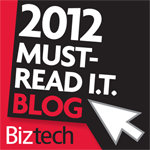 I figured it was about time for me to tackle the CIO dashboard topic since you’ve been good enough to read along so far and were probably wondering if I would ever get around to it. I think this is a pretty substantial topic, so I plan to use a series of posts to cover it over the next few weeks.
I figured it was about time for me to tackle the CIO dashboard topic since you’ve been good enough to read along so far and were probably wondering if I would ever get around to it. I think this is a pretty substantial topic, so I plan to use a series of posts to cover it over the next few weeks.
Part 1 (this post) explores the rationale for and attributes of a CIO dashboard. Part 2 will discuss dashboard audience. Part 3 will cover dashboard design considerations and offer some examples. The last post, Part 4, will summarize things in a 10 tips list.
Why Do You Need a CIO Dashboard?
Come on, aren’t you already swimming in data? Most people are, but there are a few paralyzed by reporting - sort of a feast of famine situation. Nevertheless, the idea of a dashboard is appealing.
Here are some of the reasons I have heard for taking on this kind of project:
- “I need a summary of what’s going on across IT”
- “I want to show progress that IT is making toward our goals”
- “I need to better justify IT investments to the organization”
- “I need a way to track a specific target set by the CEO/my boss”
Consider a comment from JP Morgan Chase CEO Jamie Dimon on how he and his leadership team work (from Fortune, June 8, 2009):
You have to be very disciplined, and this is even more important in a crisis. Our management team, 15 to 30 people, talk every day at 7:30, 12 noon, and five o’clock - what’s going on, sharing information, making some decisions on the spot, reviewing facts and information.
In plain English is a requirement for all of his team to be armed with the right information every day that can be used to make timely decisions. This is what I would want my CIO dashboard to do for me.
5 Characteristics of a CIO Dashboard
These are the five as the core attributes of a CIO dashboard, or any management dashboard for that matter:
- One Page in Length
- Easy to Read
- Doesn’t Require a Decoder Ring
- Accurate
- Up-to-Date
One Page in Length
In keeping with the simplicity theme, a management dashboard should contain no more information than can fit on 1 8.5×11 page (or 1 window). Furthermore, while we would all like to think we live in a 100% digital world, the dashboard should be printable - a requirement if you have senior management as your audience.
Easy to Read
To quote Edward Tufte in his seminal The Visual Display of Quantitative Information:
Data graphics should draw the viewer’s attention to the sense and substance of the data, not to something else.
A good dashboard needs to be low on the chartjunk and generous with white space.
Doesn’t Require a Decoder Ring
Not only should a dashboard be easy to read, the data must stand on its own and not required a legend or key. For example, one of my insurance clients has a composite metric to measure and report on the “health” of a major replatforming program - red, yellow, green. Much quantitative and quantitative data combine to create the measure, but it is not simple or transparent. Instead, they would be better served by reporting metrics like budget to complete and earned value measures.
Accurate
One of the biggest challenges in management reporting is data accuracy. A CIO of a regional bank I have been working with wants to understand how much of her staff are working on strategic projects. The problem is that the time tracking system only provides maintenance and trouble-ticket related categories and some generic project buckets. The resulting data is virtually meaningless.
Up to Date
The dashboard metaphor often leads to a desire for real-time data. I purposely use the term up-to-date instead because real-time data is both extremely difficult to deliver accurately and almost never needed.
In the next post, I will lay out some ideas about tailoring your dashboard to your audience and some design considerations, including online versus printed dashboards. I look forward to your comments and suggestions.
Go to the next post: 4 Types of CIO Dashboards
Did you enjoy this article? Please subscribe to CIO Dashboard to receive the latest posts!




Pingback: Twitted by Sarimk
Pingback: The CIO Guide to Dashboards — CIO Dashboard
Pingback: Social Media Monitoring and Analysis: A Hot CIO-CMO Conversation — CIO Dashboard